COX'S BAZAR, Bangladesh – Packed inside a bamboo hut, the children’s eyes light up as they watch an unfamiliar furry character on an unfamiliar screen.
Most of the Rohingya children inside the world’s largest refugee camp here have never watched television. Now, with the help of a battery-powered projector, they’re laughing along with Elmo, the lovable Sesame Street character.
The clip, shown to the children earlier this year, is just a preview. Sesame Street will soon become an integral part of their experience at this sprawling settlement, home to more than 1 million Rohingya refugees who fled ethnic violence in neighboring Myanmar.
In a project more than a year in the making, Sesame Workshop is rolling out its first Rohingya Muppets, revealed exclusively by NBC News.
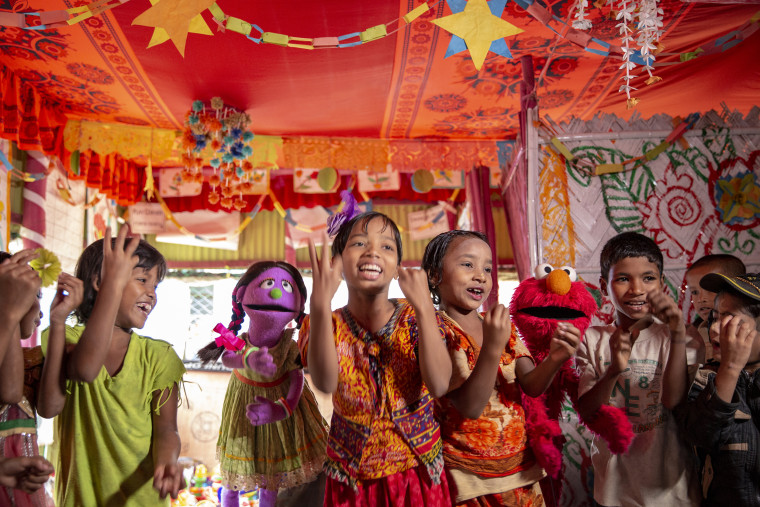
The characters, a pair of twins named Noor Yasmin and Aziz, are part of a $200 million effort to expand upon an innovative form of education at the camp.
“If we can help these children get off on the right start, where they can thrive, then they have so much more of a chance of succeeding later on,” Sherrie Westin, president of social impact for Sesame Workshop, said.
Westin is convinced that without a massive intervention by Sesame Street and its partners, the young Rohingya risk growing up unable to read and write or do simple math.
“Many of these children have experienced unthinkable horrors,” she said.
“Today, you have the neuroscience to show that if a child is exposed to traumatic experiences and prolonged stress that it literally debilitates brain development. For us to reach children in those critical early years, but especially children who've experienced trauma, we can play a significant role.”
Hundreds of thousands of Rohingya Muslims flooded into Bangladesh in August 2017 to escape a brutal crackdown by the Myanmar military.
The United Nations High Commissioner for Human Rights has described the government campaign as a “textbook example of ethnic cleansing.” At least 6,700 Rohingya, including at least 730 children under the age of 5, were killed in the month after the violence broke out, according to the medical charity Doctors Without Borders.
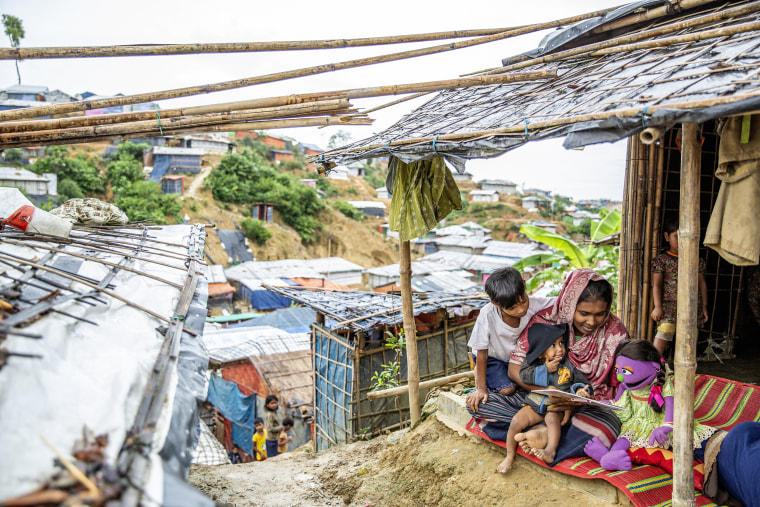
Over the next two years, roughly 200 Rohingya villages were razed, according to the U.N.
Most of those who fled the violence have been living at the Cox’s Bazar camp ever since.
Many of the roughly 700,000 children here have lost their parents. They live with other family members inside cramped huts made of bamboo and tarpaulin, with no running water or electricity. The refugees must walk to the limited pumping stations scattered throughout the camps to access clean water.
A grandmother named Merula has been living at the camp with her daughter and two grandchildren, ages 4 and 2 1/2, for the past two years. Merula said her family ran for their lives when members of the Myanmar military showed up at their village and set it on fire.
“We thought we would be killed,” she said.
The children, Ismabela and Bibijan, participate in an educational program at the camp known as the Humanitarian Play Lab. Developed by the humanitarian group BRAC, the lab uses play to help young children learn and recover from trauma.
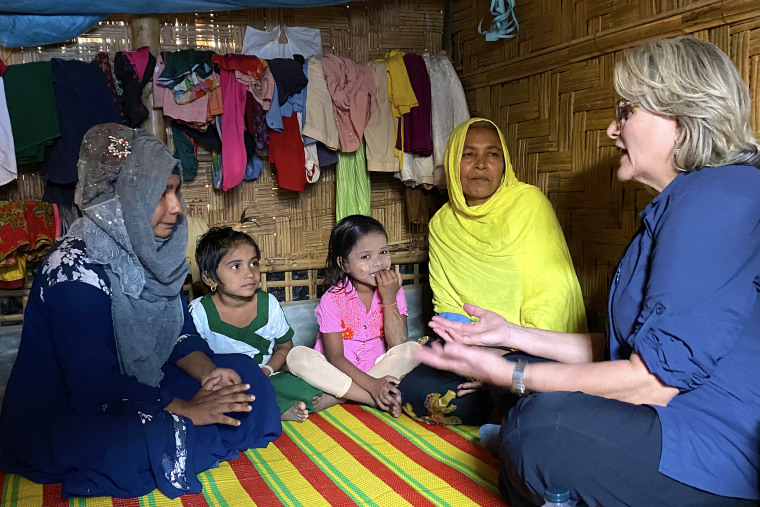
“She’s getting clever,” Merula said of Ismabela.
Many parents and caregivers said they view education as the only way for the children to improve their lot in life.
“Without education, they are blind,” one mother packed into a makeshift tent during a women-only support group meeting said.
But with so many children and limited resources, learning opportunities have been scarce at refugee camps like this one.
The vast majority of humanitarian aid tends to go toward food and shelter. Less than 3 percent of all aid is used for education, Westin said.
“And only a tiny sliver to early education,” she added. “And yet, when these situations are so long and so protracted, if children who aren’t going back home and we’re not providing education, how can they expect to have the skills they need?”
Enter Sesame Street and friends.
In the past three years, Sesame Workshop and the International Rescue Committee received two grants of $100 million – one from the MacArthur Foundation, the other from the LEGO Foundation – to create new ways to provide education for children who were growing up in refugee camps in Syria and Bangladesh.

“Children in crisis settings not only need quality education opportunities but also ways to address their own stress and socioeconomic well-being,” John Goodwin, CEO of the LEGO Foundation, said.
BRAC, Sesame's nonprofit partner on the ground in Bangladesh, has a history of educational success outside the camps: 85 percent of kids at BRAC schools complete the fifth grade.
The development of the new Rohingya Muppets began last year.
The Sesame team first explored reactions to characters such as Elmo and Grover from its Indian co-production. They also sought feedback from the Rohingya children’s caregivers – a process that Westin said revealed a particular fondness for characters that value education, honesty and caring for others.
The design team created initial character sketches, but before moving forward the Sesame executives wanted to solicit feedback from the people who mattered most.
In February, just before the Covid-19 pandemic hit, about a dozen Rohingya children and their caregivers gathered for a focus group led by Kim Foulds, senior director of international research and evaluation at Sesame Workshop.
The meeting demonstrated Sesame’s exacting approach to creating new characters. The Sesame executives wanted to hear directly from the children themselves on what kinds of Muppets would resonate with them.
“We know that children learn best when they see themselves,” Westin said. “So it’s so important that they identify with these characters.”
Inside a colorful space adorned with children’s art on the walls, Foulds presented the kids with a set of four pictures and, with the help of a translator, asked them to choose which they preferred.
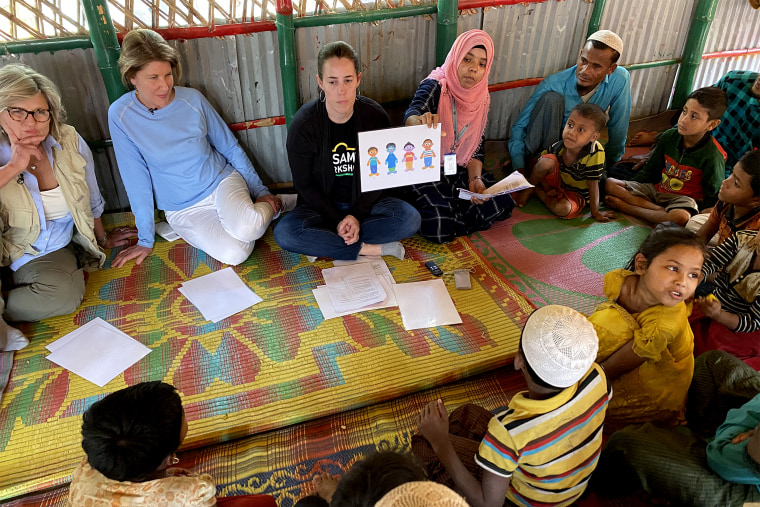
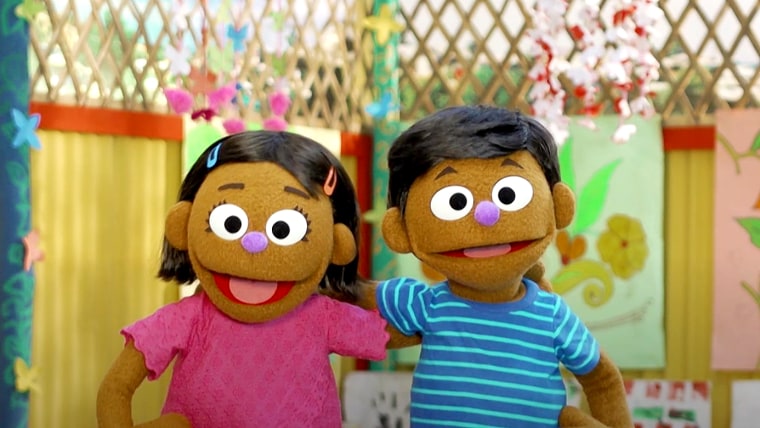
The girls went first. The black and white characters had different clothing, hair styles and footwear. Staring at the set of four, the first girl to answer showed perhaps too much enthusiasm.
“All of them,” she said when asked to pick the one she liked most.
Questions were also directed at the parents.
“Which one of these characters would you most want children in your community to say hello to?” Foulds asked.
Later, she asked: “Which of these is most likely to go to school?”
As the session went on and the children were presented with characters in color, the feedback got more specific – exactly what the Sesame executives had hoped for.
Some of the girls thought one of the female muppets had too much lipstick. A boy said he liked that one of the characters was wearing sandals.
The children were ultimately asked to choose their favorite and select a name. Foulds ended the roughly 30-minute session with a thank you and a promise.
“We’re going to take all of the feedback that you’ve given us, share it with our teams back home, and create content that looks like you, speaks to what you like best, what you don’t like,” she said. “And we’re going to create two new Rohingya muppets for you and your friends.”
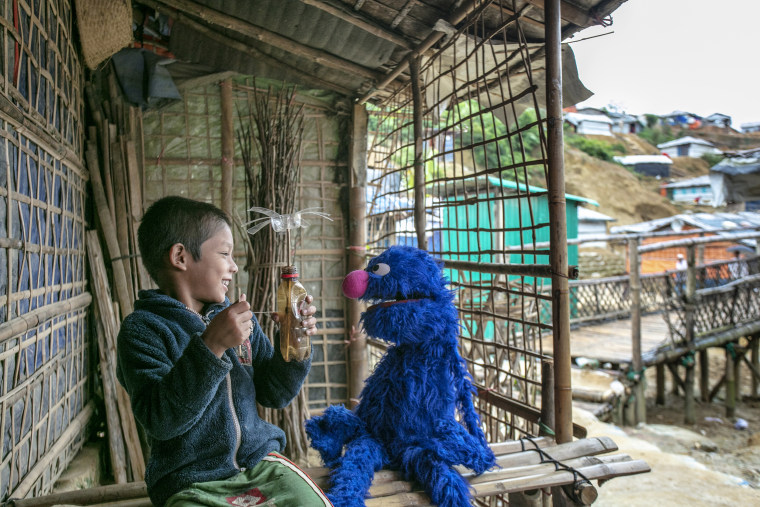
On the other side of the camp, a special guest had arrived: a blue muppet with an unmistakable voice, Grover.
Grover, who was brought to life by a puppeteer from Bangladesh, was soon surrounded by delirious children. Each child was given the opportunity to take a photo with the muppet.
For many of them, it would be the only photo they ever had.
Later on, Grover helped to lead a session at the Humanitarian Play Lab. The children watched a video about feelings – and how to manage them – before the muppet led them in song and dance.
“Children the world over just adore these characters,” Westin said.
Rohingya kids will soon have two to call their own.
The muppets, Noor and Aziz, are described as being six years old and living in the Cox’s Bazar settlement with their family.
They will be featured in printed materials available to the children this spring. Video segments – focused on social-emotional learning, math, science, health and safety – are expected to be ready by next September.
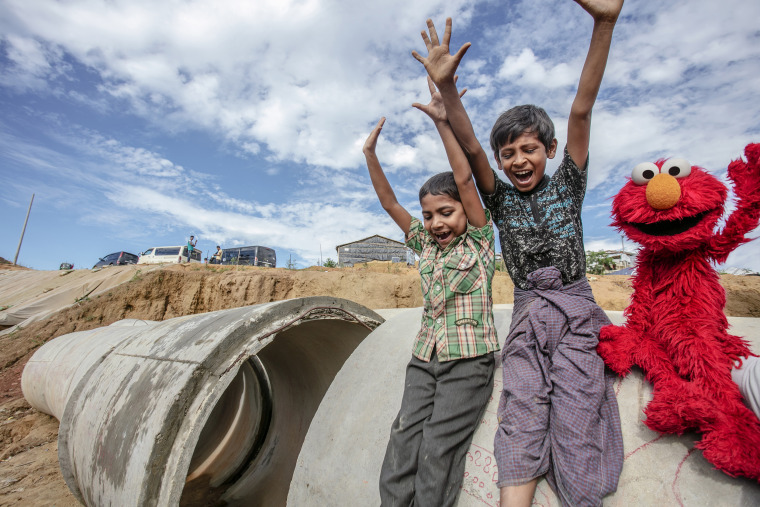
“Noor and Aziz not only share similar experiences with many of the children who find themselves in the crisis, they will also help these young children to overcome trauma and stress, and build resilience, while engaging in fun play-based learning activities,” Sarah Bouchie, chief impact officer at the LEGO Foundation, said.
Westin said the characters were a natural extension of Sesame Street’s efforts to connect with children around the world and tackle challenging issues “from the lens of a child.” She noted the creation of the first HIV-positive muppet for South African children and the production of a Sesame Street for Israeli and Palestinian kids.
“This is an investment in a more stable world for everyone,” she said. “If we invest in reaching young children in humanitarian settings, it will change the world.”

